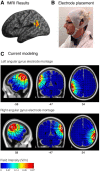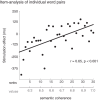Causal Evidence for a Mechanism of Semantic Integration in the Angular Gyrus as Revealed by High-Definition Transcranial Direct Current Stimulation
- PMID: 27030767
- PMCID: PMC4812139
- DOI: 10.1523/JNEUROSCI.3120-15.2016
Causal Evidence for a Mechanism of Semantic Integration in the Angular Gyrus as Revealed by High-Definition Transcranial Direct Current Stimulation
Abstract
A defining aspect of human cognition is the ability to integrate conceptual information into complex semantic combinations. For example, we can comprehend "plaid" and "jacket" as individual concepts, but we can also effortlessly combine these concepts to form the semantic representation of "plaid jacket." Many neuroanatomic models of semantic memory propose that heteromodal cortical hubs integrate distributed semantic features into coherent representations. However, little work has specifically examined these proposed integrative mechanisms and the causal role of these regions in semantic integration. Here, we test the hypothesis that the angular gyrus (AG) is critical for integrating semantic information by applying high-definition transcranial direct current stimulation (tDCS) to an fMRI-guided region-of-interest in the left AG. We found that anodal stimulation to the left AG modulated semantic integration but had no effect on a letter-string control task. Specifically, anodal stimulation to the left AG resulted in faster comprehension of semantically meaningful combinations like "tiny radish" relative to non-meaningful combinations, such as "fast blueberry," when compared to the effects observed during sham stimulation and stimulation to a right-hemisphere control brain region. Moreover, the size of the effect from brain stimulation correlated with the degree of semantic coherence between the word pairs. These findings demonstrate that the left AG plays a causal role in the integration of lexical-semantic information, and that high-definition tDCS to an associative cortical hub can selectively modulate integrative processes in semantic memory.
Significance statement: A major goal of neuroscience is to understand the neural basis of behaviors that are fundamental to human intelligence. One essential behavior is the ability to integrate conceptual knowledge from semantic memory, allowing us to construct an almost unlimited number of complex concepts from a limited set of basic constituents (e.g., "leaf" and "wet" can be combined into the more complex representation "wet leaf"). Here, we present a novel approach to studying integrative processes in semantic memory by applying focal brain stimulation to a heteromodal cortical hub implicated in semantic processing. Our findings demonstrate a causal role of the left angular gyrus in lexical-semantic integration and provide motivation for novel therapeutic applications in patients with lexical-semantic deficits.
Keywords: brain stimulation; compositionality; inferior parietal cortex; semantic integration; semantic memory; tDCS.
Copyright © 2016 the authors 0270-6474/16/363829-10$15.00/0.
Figures




Similar articles
-
Converging evidence for the neuroanatomic basis of combinatorial semantics in the angular gyrus.J Neurosci. 2015 Feb 18;35(7):3276-84. doi: 10.1523/JNEUROSCI.3446-14.2015. J Neurosci. 2015. PMID: 25698762 Free PMC article.
-
Automatic and Controlled Semantic Retrieval: TMS Reveals Distinct Contributions of Posterior Middle Temporal Gyrus and Angular Gyrus.J Neurosci. 2015 Nov 18;35(46):15230-9. doi: 10.1523/JNEUROSCI.4705-14.2015. J Neurosci. 2015. PMID: 26586812 Free PMC article.
-
Heteromodal Cortical Areas Encode Sensory-Motor Features of Word Meaning.J Neurosci. 2016 Sep 21;36(38):9763-9. doi: 10.1523/JNEUROSCI.4095-15.2016. J Neurosci. 2016. PMID: 27656016 Free PMC article.
-
Transcranial Direct Current Stimulation Effects on Semantic Processing in Healthy Individuals.Brain Stimul. 2016 Sep-Oct;9(5):682-691. doi: 10.1016/j.brs.2016.05.003. Epub 2016 May 12. Brain Stimul. 2016. PMID: 27288226 Review.
-
Multiple functions of the angular gyrus at high temporal resolution.Brain Struct Funct. 2023 Jan;228(1):7-46. doi: 10.1007/s00429-022-02512-y. Epub 2022 Jun 8. Brain Struct Funct. 2023. PMID: 35674917 Review.
Cited by
-
Common Neural System for Sentence and Picture Comprehension Across Languages: A Chinese-Japanese Bilingual Study.Front Hum Neurosci. 2019 Oct 25;13:380. doi: 10.3389/fnhum.2019.00380. eCollection 2019. Front Hum Neurosci. 2019. PMID: 31708762 Free PMC article.
-
Time-Lagged Multidimensional Pattern Connectivity (TL-MDPC): An EEG/MEG pattern transformation based functional connectivity metric.Neuroimage. 2023 Apr 15;270:119958. doi: 10.1016/j.neuroimage.2023.119958. Epub 2023 Feb 21. Neuroimage. 2023. PMID: 36813063 Free PMC article.
-
The role of the angular gyrus in semantic cognition: a synthesis of five functional neuroimaging studies.Brain Struct Funct. 2023 Jan;228(1):273-291. doi: 10.1007/s00429-022-02493-y. Epub 2022 Apr 27. Brain Struct Funct. 2023. PMID: 35476027 Free PMC article.
-
Neuroanatomical and cellular degeneration associated with a social disorder characterized by new ritualistic belief systems in a TDP-C patient vs. a Pick patient.Front Neurol. 2023 Oct 11;14:1245886. doi: 10.3389/fneur.2023.1245886. eCollection 2023. Front Neurol. 2023. PMID: 37900607 Free PMC article.
-
High-definition transcranial direct current stimulation (HD-tDCS) of the left middle temporal gyrus (LMTG) improves mathematical reasoning.Brain Topogr. 2023 Nov;36(6):890-900. doi: 10.1007/s10548-023-00996-3. Epub 2023 Aug 4. Brain Topogr. 2023. PMID: 37540333 Clinical Trial.
References
Publication types
MeSH terms
Substances
Grants and funding
- R01 NS044266/NS/NINDS NIH HHS/United States
- P01 AG032953/AG/NIA NIH HHS/United States
- P30 AG010124/AG/NIA NIH HHS/United States
- NS053488/NS/NINDS NIH HHS/United States
- P01 AG017586/AG/NIA NIH HHS/United States
- AG017586/AG/NIA NIH HHS/United States
- R01 AG038490/AG/NIA NIH HHS/United States
- T32 AG000255/AG/NIA NIH HHS/United States
- AG038490/AG/NIA NIH HHS/United States
- P50 NS053488/NS/NINDS NIH HHS/United States
- AG032953/AG/NIA NIH HHS/United States
- NS044266/NS/NINDS NIH HHS/United States
- AG00255/AG/NIA NIH HHS/United States
LinkOut - more resources
Full Text Sources
Other Literature Sources
